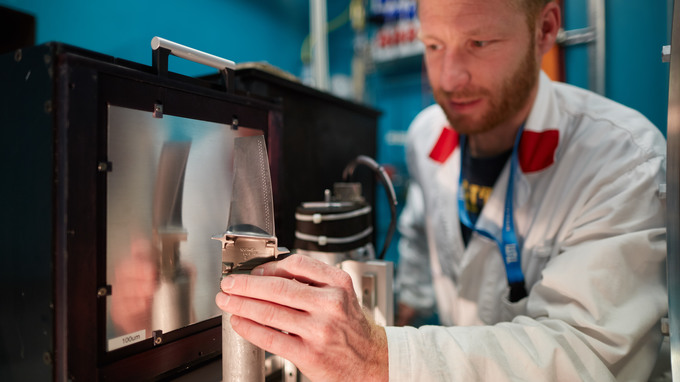16,2 Millionen Euro für Forschung mit Neutronen und Positronen
Bundesforschungsministerium: Förderung für Heinz Maier-Leibnitz Zentrum und Neutronenquelle
2016-08-29 – Nachrichten aus dem Physik-Department

Das MLZ, eine Kooperation zwischen der Technischen Universität München (TUM) und den Helmholtz-Zentren in Jülich und Geesthacht, bietet Wissenschaftlern Zugang zu den Neutronen- und Positronen-Instrumenten an der Forschungs-Neutronenquelle Heinz Maier-Leibnitz (FRM II) in Garching. Das Schwerpunktprogramm des BMBF “Erforschung kondensierter Materie an Großgeräten” fördert bis 2019 insgesamt 19 Forschungsprojekte am MLZ.
Drei wissenschaftliche Geräte werden mit Hilfe der Förderung im Laufe der nächsten drei Jahre fertig gestellt:
An der Hochdruckpresse des Bayerischen Geoinstituts in Bayreuth, SAPHiR, werden Drücke und Temperaturen wie im Erdinneren nachgestellt, um deren Auswirkung auf geologische Proben zu untersuchen. Die Neutronen werden Gesteinsstrukturen hochpräzise ausmessen und so zum Beispiel die Gesteinsfaltung analysieren, aber auch helfen, neue magnetische Speichermedien zu entwickeln.
Am Hochintensitäts-Flugzeitneutronendiffraktometer POWTEX der RWTH Aachen wird mit Hilfe der Förderung ein neuartiger großflächiger Neutronendetektor gebaut. Die RWTH Aachen und die Georg-August-Universität Göttingen erhalten die Gelder, um hierzu die geeignete Software zu entwickeln.
Hochgradig polarisierte Neutronen werden durch die Fördermittel am kalten Dreiachsenspektrometer KOMPASS der Universität zu Köln realisiert. Sie können schwache magnetische Ordnungen oder komplexe magnetische Systeme untersuchen, um höhere Speicherdichten in künftigen PCs zu erreichen.
Schneller messen mit BAMBUS - ERWIN ergänzt RESI bei Batterietests
Ein Multi-Detektor-System namens BAMBUS der Technischen Universität Dresden am Dreiachsenspektrometer PANDA wird es dank der finanziellen Unterstützung erlauben, die Position und Ausdehnung unbekannter Anregungen schneller zu finden. So werden Untersuchungen an möglichen Materialien für Quantencomputer oder neuartigen Supraleitern effizienter.
Zwei weitere Projekte, geleitet vom Karlsruher Institut für Technologie, zielen darauf ab, die molekularen Vorgänge beim Laden und Entladen von Batterien völlig zerstörungsfrei zu beobachten und so zu leistungsfähigeren und auch beständigeren Batterien zu gelangen: Hierzu wird das Einkristalldiffraktometer RESI um die Pulverdiffraktionsoption ERWIN (Energy Research WIth Neutrons) und das Instrument NECTAR um die Radiographie und Tomographie mit thermischen Neutronen ergänzt.
Zehn Mal kleinere Proben als mit Neutronen üblich - deutlich unter einem Kubikmillimeter - möchte die RWTH Aachen mit ihrem Projekt am heißen Einkristalldiffraktometer HEIDI untersuchbar machen und Stempeldruckzellen für Hochdruckexperimente bereitstellen.
Professoren der TUM bauen neue Messmöglichkeiten mit Neutronen
Das BMBF fördert außerdem sechs Projekte des Physik-Departments:
- Sehr hohe Temperaturen bis zu 1200°C müssen Legierungen für neue Hochleistungswerkstoffe für Gasturbinen aushalten und dabei auch zug- und druckfest bleiben. Dr. Ralph Gilles baut einen Hochtemperaturofen und eine Kühleinheit zum Testen dieser Legierungen mit Neutronen.
- Prof. Peter Böni und Dr. Robert Georgii errichten ein Modul, das an verschiedenen Instrumenten eingesetzt werden kann und es erlaubt unter kleinen Streuwinkeln magnetische und strukturelle Anregungen auch in hohen Magnetfeldern zu messen.
- Prof. Christian Pfleiderer plant am Neutronenspinecho-Spektrometer RESEDA eine Erweiterung, die bei hohen Magnetfeldern und ultra-hoher Auflösung die Intensität der Neutronen steigert.
- Eine Kombination aus Röntgen- und Neutronenstrahlen wird an der Tomografieanlage ANTARES zukünftig noch bessere Bilder etwa aus dem Inneren von Batterien erzeugen. Das Projekt namens NeuRoFast wird von Prof. Franz Pfeiffer koordiniert.
- Um noch höher aufgelöst und in tieferen Schichten Lithium in Batterien oder Bor in siliziumhaltigen Photovoltaikzellen messen zu können, baut Prof. Bastian Märkisch das Instrument PGAA weiter aus.
- Das Flugzeitspektrometer TOFTOF erhält mit Hilfe der BMBF-Förderung an Prof. Peter Müller-Buschbaum (TUM) eine neue Probenumgebung, mit der man etwa bakteriellen Proteinen während der Photosynthese zusehen kann.
Kürzere Messzeiten bei den Positronen
Damit Proteine am MLZ zusätzlich zu den Neutronen auch mit anderen spektroskopischen Instrumenten untersucht werden können, baut die RWTH Aachen das biologische Labor aus. Wie Nanopartikel dreidimensional angeordnet sind, lässt sich künftig mit der von der Friedrich-Alexander-Universität Erlangen-Nürnberg weiterentwickelten Software BornAgain untersuchen.
Neben Neutroneninstrumenten wird auch die weltweit intensivste Positronenquelle am FRM II mit den BMBF-Geldern weiter ausgebaut:
Unter anderem erweitert die Universität der Bundeswehr München das Rasterpositronenmikroskop und den gepulsten Positronenstrahl so, dass mehr Messungen mit den Antiteilchen der Elektronen in kürzerer Zeit möglich sind.
Dr. Christoph Hugenschmidt von der TU München entwickelt ein völlig neuartiges Positroneninstrument zur hochpräzisen Bestimmung von Oberflächenstrukturen und der drei-dimensionalen Verteilung von Kristalldefekten.
“Einmalig große Bandbreite”
“Mit der BMBF-Verbundforschung wird auf geradezu ideale Weise die universitäre Forschung in die Nutzung des MLZ eingebunden.”, sagt Prof. Winfried Petry, Wissenschaftlicher Direktor des FRM II und MLZ. “Gleichzeitig können wir mit dem Neubau von wissenschaftlichen Instrumenten, aber auch deren Weiterentwicklung, weltweit die attraktivsten Messgäste anlocken.”
Direktor des Jülich Centre for Neutron Scattering (JCNS) und Wissenschaftlicher Direktor am MLZ Prof. Brückel ergänzt: “Das Heinz Maier-Leibnitz Zentrum deckt mit den geförderten Projekten eine einmalig große Bandbreite von Lebens- und Gesundheitswissenschaften mit Proteinforschung, über Nano- und Ingenieurwissenschaften bis hin zur Energieforschung an Batteriesystemen ab.”
Das Heinz Maier-Leibnitz Zentrum (MLZ) ist führend in der Spitzenforschung mit Neutronen und Positronen. Als wissenschaftliche Nutzereinrichtung an der Forschungs-Neutronenquelle FRM II bietet das MLZ eine einzigartige Auswahl an rund 30 Hochleistungsneutronen-Messgeräten für Gastwissenschaftler an. Das MLZ ist eine Zusammenarbeit der Technischen Universität München, des Forschungszentrums Jülich und des Helmholtz-Zentrums Geesthacht Zentrum für Material- und Küstenforschung (HZG). Diese Kooperation wird vom Bundesministerium für Bildung und Forschung (BMBF) und dem Bayerischen Staatsministerium für Bildung und Kultus, Wissenschaft und Kunst finanziell unterstützt. Weitere Universitäten und die Max-Planck-Gesellschaft engagieren sich an Messinstrumenten des MLZ.
Die Forschungs-Neutronenquelle Heinz Maier-Leibnitz (FRM II) stellt Neutronenstrahlen für Forschung, Industrie und Medizin zur Verfügung. Sie wird von der Technischen Universität München betrieben und vom Bayerischen Staatsministerium für Bildung und Kultus, Wissenschaft und Kunst finanziert.
- Redaktion:
- Andrea Voit (FRM2) / S. Reiffert (TUM) / Dr. Johannes Wiedersich